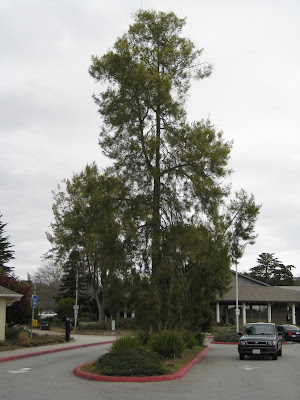The Casuarina species all look the same to me, not up close but from the leaves, they look like horsetails, from the genus Equisetum. They have lots of common names, one is the horsetail tree, others include she-oak, ironwood, or beefwood. Regardless, this native of Australia has become naturalized and invasive in many parts of the county.
They are fast growing evergreen trees to 40-50 feet and about 20 wide. The habit is somewhat pyramidal with weeping lateral branches. With leaves that look like pine needles it adds to the weeping look.
The foliage resembles a pine or as I mentioned a horsetail. If you look at the stems closely you will see that they look jointed. The joints are where the leaves are. They are highly reduced to only little nubs, 6-8 or so at each joint. You can see the ends near the bottom right of the image where one of the branches was pulled off, just like a horsetail.
Flowers are interesting to look at and make it pretty obvious they are not conifers with long needles. They are said to be unisexual (dioecious) resulting in male and female trees. These are females, as the males are said to be at the tips of the branches.
Fruit is a cone like structure as well, again leading to the impression that these trees are conifers. They are really clusters of follicles like a magnolia aggregate fruit.
Trunk is gray brown, pretty smooth till older then small persistent scales.
Misidentification: not a conifer.
Locations:
Aptos: Several at Cabrillo College by the Sesnon house parking lot.
Along Soquel Drive at Crawfords Antiques.









































